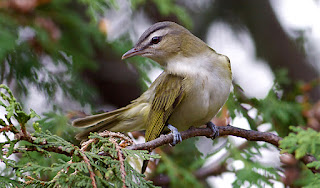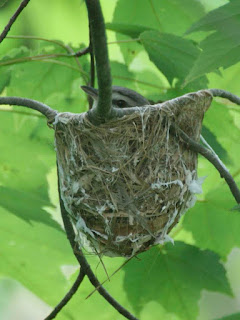Red-eyed vireos are summer residents of Potomac Creek. “Obligate” migrants, they arrive here each spring, having traveled all the way from Amazonia. The long journey is incredibly stressful; many don’t make it.
Yet this challenge alone doesn’t separate red-eyed vireos
from the other migratory birds who come here. Warblers, flycatchers, osprey,
and other avians of many kinds, including the brilliant scarlet tanager, also
undertake arduous spring and fall migrations, sometimes in the company of
vireos. Nature doesn’t hand out sturdy wings for nothing.
 |
| Credit: Minnesota Breeding Bird Atlas |
Rather, I have learned that what makes the species extraordinary,
even in the company of its migratory peers, is its outstanding musicianship.
Red-eyed vireos are not just exceptionally powerful singers. They’re
songwriters, too. In some ways, the male vireo rivals the most prolific human
stars – our Lennon & McCartneys and Taylor Swifts.
Consider song production. The red-eyed vireo is commonly
thought to hold the songbird record for prolificacy. This talent was dramatically
revealed by Swedish-born nurse Louise de Kiriline Lawrence, an unlikely star in
ornithology circles. An emigré to Canada, Lawrence escaped the Bolsheviks who
captured her first husband, and helped raise the world’s first surviving
quintuplets. But Lawrence was also a devoted naturalist. On May 27, 1952, she
sat intently in woods nearly two hundred miles north of Toronto and listened as
a recently arrived vireo sang his heart out. Over nearly fourteen hours between
predawn and the bird’s late afternoon rest, Lawrence observed an astonishing
22,197 distinct calls. (The typical songbird sings between 1,000 and 2,500
times per day.) At times, the vireo in question sang at a clip of 70 songs per
minute.
Lawrence marveled at the male
bird’s determination to sing. His treetop performance seemed to suggest much more
than simple, repetitive vocalizations; Lawrence believed she was hearing something
closer to art. Her review reads like an evening at the opera:
He sang, phrase following
upon phrase, with just enough interval to mark a disconnection between them. He
sang with an aloof intensity and confluence that seemed to divorce his
performance totally from any special objectives and reasons. This bird sang
simply because self-expression in song was as much a part of his being as his
red eye.
Inspired by Lawrence, ornithologist Donald Kroodsma
recorded 200 songs of a single male vireo he chanced upon during a trip in
Massachusetts. Sonagram analysis allowed him to identify twenty individual
songs, supporting reports that a male’s repertoire may reach thirty or forty.
Kroodsma’s tapes also confirmed that each male red-eyed vireo has his own, distinct
set of songs. Neighboring vireos sang their own, different tunes. Even more astonishing is that the males improvise
their tunes. It’s not all mimicry.
So, why does this articulate little bird sing so
obsessively? And what is he singing for?
A confession: I struggle to memorize bird calls and songs.
My kids once had a wonderful book that electronically reproduced the calls of
American songbirds. We enjoyed learning them together, recognizing many melodic
tweets and chirps from our time outdoors. But I quickly forgot nearly
everything. I have the same problem learning Celtic fiddle tunes. The names of
spirited jigs and reels simply don’t provide enough information for easy recall
of the melodies they describe. Is “Dunford’s Fancy” the one that begins with
the quick da-da-dum triplet, then jumps to the D string? Or is that “Cuckoo’s
Nest,” or perhaps “Drowsy Maggie?” I’ll go to my grave asking no matter how
many St. Patrick’s Day gigs I play. Similarly, I know what an American robin
looks like. I also recognize its song as a melody I’ve heard all my life. Just
don’t expect me to connect the dots without more clues.
This deficiency limits my ability to know the wider world
brimming with animal sounds and voices. Of course, our planet wasn’t
always so musical. Biologist David George Haskell writes that for more than
ninety percent of its history, Earth was silent apart from the elemental sounds
of “stone, water, lightning, and wind.” Now, nearly all life creates sound. Up to ninety percent of insects communicate through a “vibroscape” of
shaking ground or foliage. Even bacteria, we have learned –
once we had the right equipment to know and bothered to ask – make measurable
noise by waving their tiny flagella.
The greater question, then, has to be why anyone
sings. The ancients defined “animal,” a word derived from the Latin animalis,
as the living thing “having breath.” To lose this breath is to become exanimalis,
or lifeless. But animal “voice” only appeared after billions of years of
evolution, probably because a noisy animal could outcompete a quiet one.
Accordingly, sound now connects many living things into networks of connection
and conversation, its varying pitches, timbres, rhythms, and amplitudes
carrying nuanced messages. We humans evolved, and have
always lived, within nature’s musical theater.
Yet red-eyed vireos must first learn to deliver such
messages. Vireo young are babblers. In their first
months, they imitate and improvise “subsongs” as they try to define their own
tunes. Dopamine, the “feel good” hormone behind learning and
motivation, plays a key role: more is released when the bird sings better,
making learning pleasurable. The mature male, on the other hand, has a lengthy set-list
of established songs. Like an aging pop star bound in his ways, he may prefer
to run through his whole set list before starting another bout of singing.
That said, relentless piping also expends tremendous
energy, a resource vireos must husband carefully given their taxing lives. All
this calling and singing must therefore serve a purpose.
For the most part, it’s not too hard to guess why the birds
vocalize. Male vireos scream at rivals who approach their territory, for
example. Little mystery there. The compulsion to
organize our space on earth is a well-known spring of creative sound making.
But their singing continues long after the territories are
defined, and – unusually for songbirds – even after vireo mates are paired off.
We may never know why the male vireo sings so prolifically when his greatest
needs already seem to have been met (they even continue to sing, albeit less
than before, in the lush abundance of Amazonia). Ornithologist Kroodsma notes,
however, that the sheer effort and amount of song produced suggests there’s
still a lot at stake for the male bird. Kroodsma’s own guesses center on the
female vireo. Perhaps the male’s partner is always listening to him sing.
Perhaps his musicianship informs her egg laying choices. In essence, he may
always be courting her. If she likes what she hears, the bird’s odds of
becoming a successful father may increase. In humans, “groovy music” is associated with heightened
arousal. Why not for love-struck vireos?
If these hypotheses are true, then male red-eyed vireos
call to define place and sing to attract and communicate with mates, like other
songbirds do. Like I do. Like the peoples of Potomac Creek have always done.
***
It’s also possible – likely, even – that the little birds
simply enjoy singing.
This shouldn’t be too controversial. Nature embraces
emotion and pleasure, including – but not exclusively – for purposes of sex.
Charles Darwin watched his first child’s earliest emotive beginnings with
intense interest, convinced “that the most complex and fine shades of
expression must all have had a gradual and natural origin.” (The mental image of this giant of science detachedly
observing his primate son’s behavior is irresistible.)
That some sounds clearly please or displease animals should
be obvious. At the chemical level, the act of singing well enhances pleasure even
in adult songbirds, measured through raised dopamine levels. Many studies confirm sound’s effects on animal behavior, too.
Science aside, pet owners have ready windows into the world
of animal preferences. As a boy I delighted in how our Afghan hound, Cici, howled
in unison with me. Cici plainly enjoyed our extended duets. She soulfully tossed
back her elegant head and long, blonde hair to project her voice upward to the
heavens.
Today, our house cat Minou offers insight into what might
be called animal musical taste. Minou never leaves her favorite napping
spot when my son plays his guitar. She doesn’t mind hearing someone play the
electric piano, either. In fact, if the piano is left on, she will happily
pussyfoot across its keyboard, creating amusing, dissonant “tunes,” presumably
without design. But whenever I bring out my fiddle Minou skitters downstairs
into the basement, tail flying. (And that’s despite the fact I usually play
with a sound-dampening practice mute.) Minou’s behavior vividly proves that
fiddle sounds – or at least the ones I make – are not at all to her
liking.
Sadly, we can’t know what emotions the listening
animal feels. Our technology and imagination simply aren’t there yet. But in Sounds
Wild and Broken, biologist David George Haskell notes that the assumption
that humans alone can experience beauty is improbable and scientifically
unsupported. Today’s models of the evolution of animal communication
argue that the chirps, roars, buzzes, clicks, and whistles found in nature
coevolved with aesthetics, as animal likes and dislikes helped power nature’s
incredible diversity of sounds. Animal aesthetic appreciation was likely a major
driver in the evolution of sound.
There’s a role for sound in animal social learning and
culture, too. A whale’s call, for example, may reveal to others of its species
“its individual identity, clan affiliation, and, in some species, whether it is
up-to-date on the latest song variants.” Those are pretty nuanced messages,
indeed. Presumably, whales receive some calls with pleasure or excitement, but
not others. And when subjective, aesthetic, and emotional meaning are attached
to sound, sound becomes music. Many animals thus exhibit musicality, the capacity
to produce and enjoy music. Philosopher and jazz clarinetist David Rothenberg, a
proponent of “interspecies music,” has been improvising with animal singers for
decades, including birds and whales. In 2000, a rambunctious duet he shared
with a white-crested laughingthrush, a highly social and vocal bird native to
Asia, helped spur a lively debate about bird consciousness and reframe how many
scientists approach animal music.
All this is to say that animal species and even individual
animals can have aesthetic preferences and appreciate beauty.
Put another way,
art “does not wait for humans to begin.”
Sadly, few of us look for sentience beyond our own kind. But
nature surrounds us with sound and voices her emotions openly. On Potomac
Creek, the return of animal music has long foretold spring and summer – the
seasons of new life – as surely as green leaves budding on tree limbs.
This spring, I was in waiting. I have learned to listen now. To walk alone and hear the fairy
song of the wood thrush carrying through the forest is to hear God’s voice; it
is to bend our ear towards earnest tunes of love and place.
It is to be
awakened to the music of creation.
 |
| Credit: https://www.pamsbackyardchickens.com/2011/06/wildlife-wednesdays-red-eyed-vireo-nest.html |